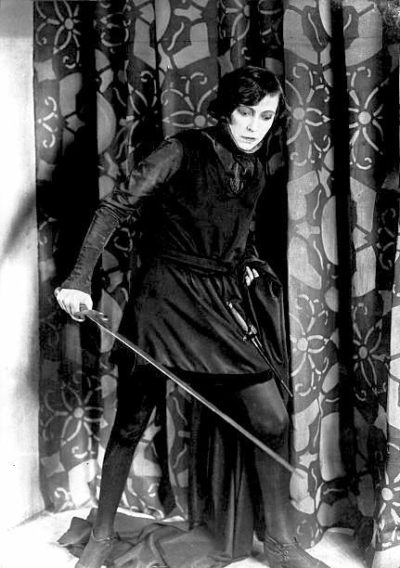★★★
“To she, or not to she…”
 Asta Nielsen was not the first woman to play the part of Hamlet, even on film. As we’ve mentioned before, a short reel of Sarah Bernhardt performing the role was made as early as 1900. But this silent Danish movie, celebrating its centenary at the time of posting, is the first full-length feature to gender switch the role. It was inspired by Edward P. Vining’s book The Mystery of Hamlet, published in 1881, which suggested that the character made a lot more sense if you considered Hamlet to be a woman. An interesting idea, to be sure, and obviously changes significantly the relationship between Hamlet and both best friend Horatio, and Ophelia.
Asta Nielsen was not the first woman to play the part of Hamlet, even on film. As we’ve mentioned before, a short reel of Sarah Bernhardt performing the role was made as early as 1900. But this silent Danish movie, celebrating its centenary at the time of posting, is the first full-length feature to gender switch the role. It was inspired by Edward P. Vining’s book The Mystery of Hamlet, published in 1881, which suggested that the character made a lot more sense if you considered Hamlet to be a woman. An interesting idea, to be sure, and obviously changes significantly the relationship between Hamlet and both best friend Horatio, and Ophelia.
Of necessity, there are therefore some changes to the story. It begins with a prelude in which Hamlet’s father is away at war when his wife Gertrude gives birth. Fearing for her husband’s life, and wanting to secure the throne’s succession, she announces the girl child as a boy [a similar plotline was used in the Indian fllm, Rudhramadevi]. On her husband’s return, they vow to keep up the pretense. We also see more of Hamlet’s youth, attending the University of Wittenberg and forming her relationship with Horatio (Stieda), before being called back to Denmark. That happens when the king is murdered by her uncle, Claudius (von Winterstein), who has quickly married her mother, Queen Gertrude (Brandt). The supernatural element of the ghost of Hamlet’s father is also removed, in favour of Hamlet discovering Claudius’s knife in suspicious circumstances.
Thereafter, however, it follows familiar lines, with Hamlet faking madness in order to be able to investigate freely, and not be considered a threat. It’s probably this version’s weakest section, since it doesn’t seem she does much actual investigating, and watching someone pretend to be insane is kinda dull, especially in a silent version, with the inevitable tendency towards the over- side of acting. There’s also an absence of the Bard’s classic dialogue, for obvious reasons: no “To be, or not to be” in this version. When Hamlet stages a play re-enacting the death of her father, things perk up and head towards the rousing if tragic finale [spoiler: just about everyone dies].
This is not quite the oldest film reviewed here, Joan the Woman preceding its 1921 release by five years. Hamlet isn’t as successful, replacing the rousing battle scenes of Joan with some fairly stagey sequences of emoting by Nielsen, which at times did struggle to hold my interest. That said, Nielsen is actually very good in the role, and some scenes have power, such as her intense slithering across the floor to watch Claudius’s reaction to the play. I’ve queued up some of her other performances for later perusal. There’s something endearingly Goth about the production here, with her Hamlet being all dressed in black, with floppy hair and eye make-up. At times it almost looks like a promo video for The Cure. But other elements, such as Ophelia’s funeral, are highly Expressionist, with the film using bold tints to indicate location.
If what has been written above has piqued your interest, the whole thing is available on YouTube. While probably not something I’ll re-visit, I can’t say I felt like my two hours were wasted. It’s certainly an interesting take on a character which continues to fascinate and provoke debate, over 400 years after the play was first published.
Dir: Svend Gade and Heinz Schall.
Star: Asta Nielsen, Eduard von Winterstein, Mathilde Brandt, Heinz Stieda




